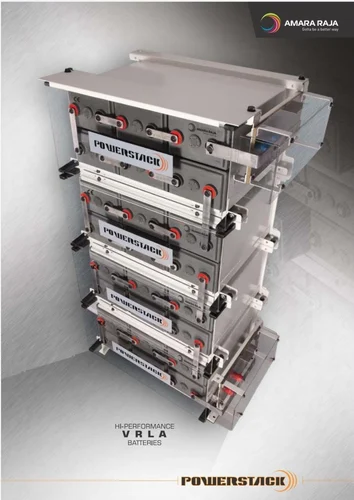Amaron Powerstack cells are a type of valve-regulated lead-acid (VRLA) battery designed for industrial applications. Here\\'s an overview of the Amaron Powerstack cells and their specifications: Key Features: Modular design for easy installation and maintenance High-performance VRLA technology for reliable power supply Low maintenance and self-discharge rate Wide operating temperature range (-20°C to 50°C) Compliance with international standards (IEC, UL, and CE) Types of Amaron Powerstack Cells: Amaron Powerstack 2V 200 Ah Cell: Capacity: 200 Ah Voltage: 2V Dimensions: 103 x 206 x 355 mm Material: Lead-Calcium alloy Terminal Type: M8 x 25 mm Copper Design Float Life: 12 Years Amaron Powerstack 2V 300 Ah Cell: Capacity: 300 Ah Voltage: 2V Dimensions: 123 x 206 x 355 mm Material: Lead-Calcium alloy Terminal Type: M8 x 25 mm Copper Design Float Life: 12 Years Amaron Powerstack 2V 400 Ah Cell: Capacity: 400 Ah Voltage: 2V Dimensions: 143 x 206 x 355 mm Material: Lead-Calcium alloy Terminal Type: M8 x 25 mm Copper Design Float Life: 12 Years Amaron Powerstack 2V 500 Ah Cell: Capacity: 500 Ah Voltage: 2V Dimensions: 163 x 206 x 355 mm Material: Lead-Calcium alloy Terminal Type: M8 x 25 mm Copper Design Float Life: 12 Years Amaron Powerstack 2V 600 Ah Cell: Capacity: 600 Ah Voltage: 2V Dimensions: 183 x 206 x 355 mm Material: Lead-Calcium alloy Terminal Type: M8 x 25 mm Copper Design Float Life: 12 Years Amaron Powerstack 2V 800 Ah Cell: Capacity: 800 Ah Voltage: 2V Dimensions: 203 x 206 x 355 mm Material: Lead-Calcium alloy Terminal Type: M8 x 25 mm Copper Design Float Life: 12 Years Amaron Powerstack 2V 1000 Ah Cell: Capacity: 1000 Ah Voltage: 2V Dimensions: 223 x 206 x 355 mm Material: Lead-Calcium alloy Terminal Type: M8 x 25 mm Copper Design Float Life: 12 Years Amaron Powerstack 2V 1200 Ah Cell: Capacity: 1200 Ah Voltage: 2V Dimensions: 243 x 206 x 355 mm Material: Lead-Calcium alloy Terminal Type: M8 x 25 mm Copper Design Float Life: 12 Years Amaron Powerstack 2V 1500 Ah Cell: Capacity: 1500 Ah Voltage: 2V Dimensions: 263 x 206 x 355 mm Material: Lead-Calcium alloy Terminal Type: M8 x 25 mm Copper Design Float Life: 12 Years Amaron Powerstack 2V 1800 Ah Cell: Capacity: 1800 Ah Voltage: 2V Dimensions: 283 x 206 x 355 mm Material: Lead-Calcium alloy Terminal Type: M8 x 25 mm Copper Design Float Life: 12 Years **Amaron Powerstack 2V 200
Send Message







